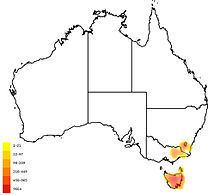Rank Species | ||
 | ||
Similar Hakea decurrens, Hakea cristata, Hakea microcarpa, Hakea epiglottis, Hakea macraeana | ||
Hakea lissosperma is a type of spreading shrub with almost 4 metres height, needle-shaped leaves and white flowers. In 1999 it was recognised that it grows commonly in over 1200 m rocky mountains, in subalpine woodland. And common names include needle bush and mountain needlewood. What is more, this species is a favourite of birds due to the dense clusters of flowers and pungent rigid needle-shaped leaves which can be a shelter against predators. It is also resistant to wildlife browsing due to its unpalatability but not suitable below powerlines.
Contents
Distribution
This species is easily found in the following areas: Break O'Day, Central Highlands, Circular Head, Derwent Valley, Dorset, Flinders Island, Glamorgan-Spring Bay, Hobart, Huon Valley, Kentish, Kingborough, Launceston, Meander Valley, Northern Midlands, Southern Midlands, Tasman, Waratah-Wynyard, West Coast.
Habitat
The community is commonly Wet Eucalypt Forest and it is widespread especially on mountains to 1200m and to sea level in areas of high rainfall. The habitat of this species is frost hardy, drought tolerant, untypical in its narrow and flexible leaves, and in its dry forest habitat at the relatively low altitude of 700 m. In addition, it has moist and shady site tolerance as well as fertile, loam, phosphorus intolerant, poor and well-drained soil tolerance.
Description
The mountain needlewood is an Australian shrub or small tree with commonly spiny leaves and dense clusters of white flowers, growing approximately from 2.0 to 6.0 m tall. In addition, the bush is a low woody plant with several main stout branches. Leaves are terete, usually 6–10 cm long, 1.5–2 mm wide, rigidly erect and glabrous with approximately 1 mm long mucro. What is more, follicles are usually 20–30 mm long, 15–20 mm wide while the mature ones are about 2.3–2.7 cm long, 1.7–2 cm wide, coarsely wrinkled or blistered.
Flowers and Regeneration
Flowers commonly form in October,November and December in alpine areas, earlier at lower altitudes, which are white or cream clustered in leaf axils on stalks usually 4–6 mm long. Perianth is usually glabrous with 5–6 mm length. Besides, according to Walsh and Entwistle (cited in Butler et al. 2006), seed is usually 17–23 mm long, 6.5-10.5 mm wide. And seed body is 6–10 mm long, wrinkled, wing down one side only, and dark blackish-brown in colour. Fruit commonly becomes hard and brown or grey-brown when it is mature usually in the second year after flowering. Immature fruit will not ripen off the plant and fruit is usually held on the plant for several years. Moreover, each fruit usually includes from 1 to 2 winged seeds (Ralph cited in Butler et al. 2006). What is more, Ralph (cited in Butler et al. 2006) points out that the seed dispersal is achieve by wind and the germination time of Hakea lissosperma is about 6 months. Seed is usually not occupying whole valve face.
Taxonomy
Hakea lissosperma was first described by Barker, Haegi and Barker in 1996, and the description was published in Flora of Australia, Volume 17B, Proteaceae 3 Hakea to Dryandra in 1999.
Cultivation
This tree is not fully hardy and it should only be planted in a sheltered location. Firstly, collect only the older fruit which is usually grey-brown, and the seed collection is suitable in the whole year. Secondly, leach the seed, and the dry fruit will usually open in 2–3 weeks or place in a hot oven 80-100 ℃ for 30 mins with the door partially open. Besides, leaching, stratification or a combination of both improves results, or moist stratify seed for 4 months in fridge for good germination. Lastly, the direct seeding is also suitable, and the germination time is approximately 6 months.
